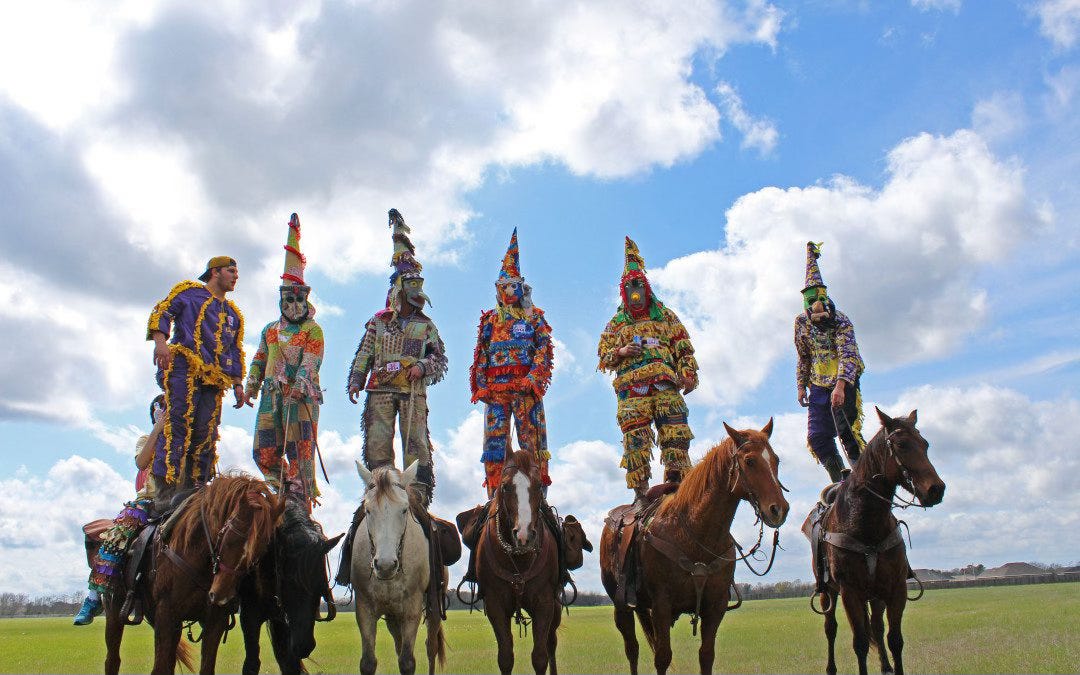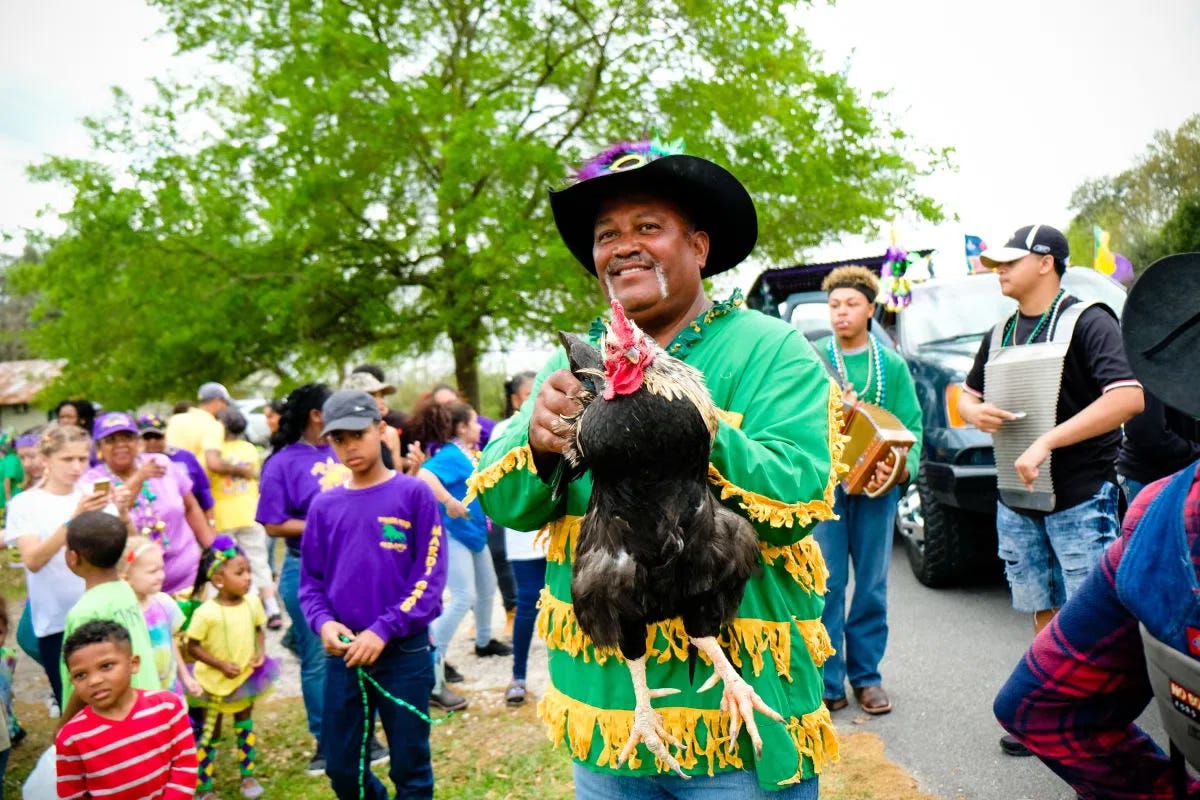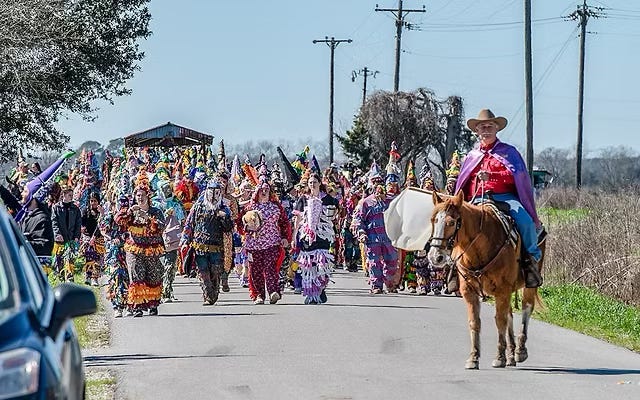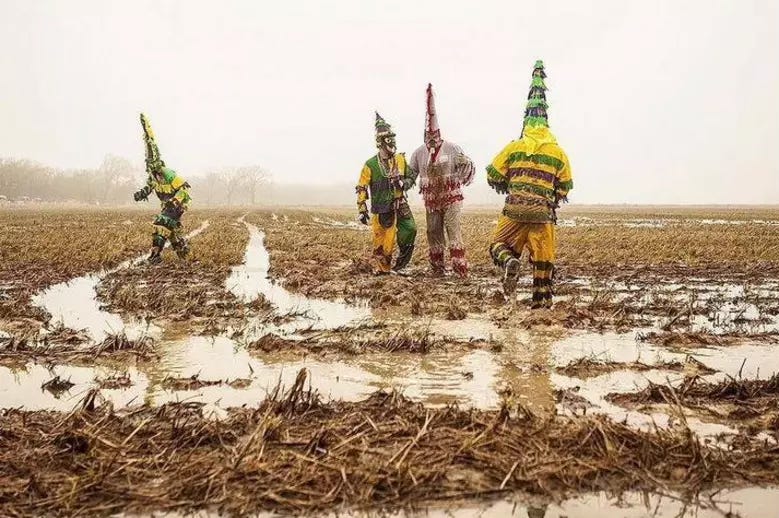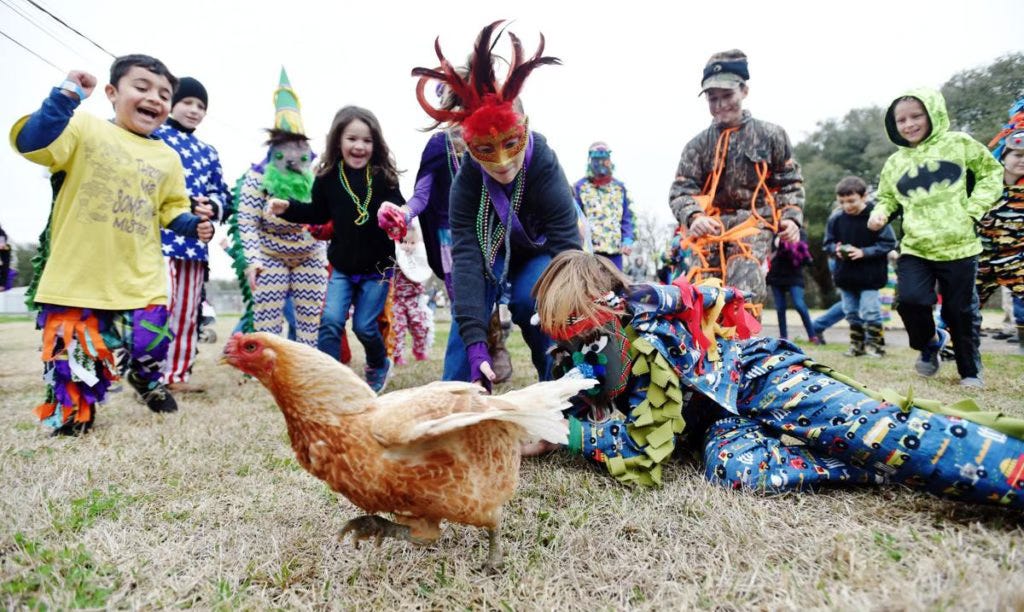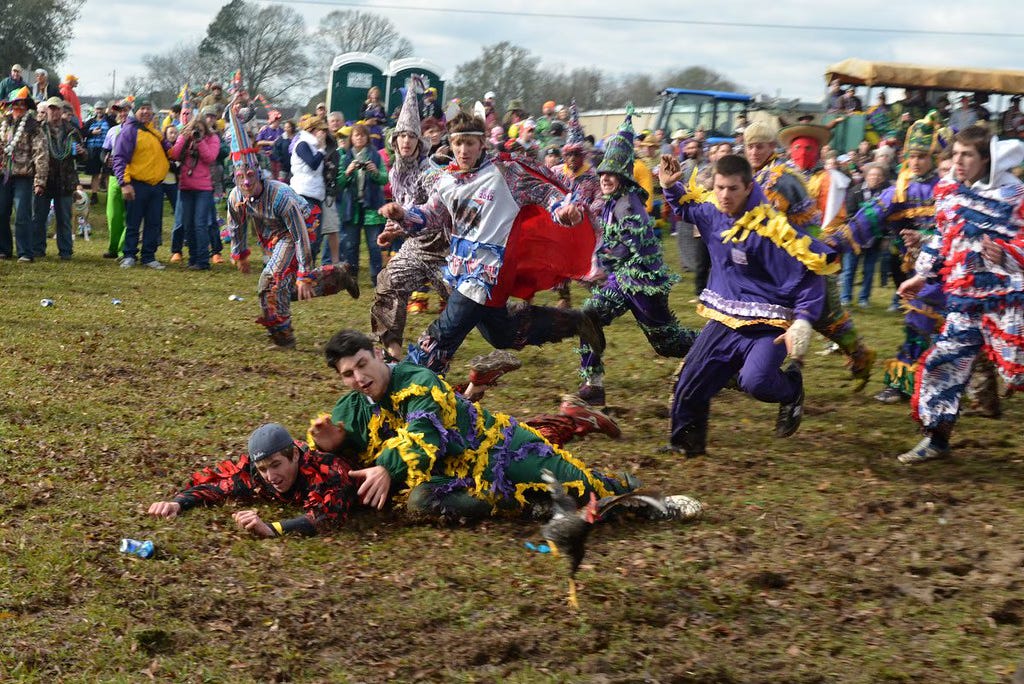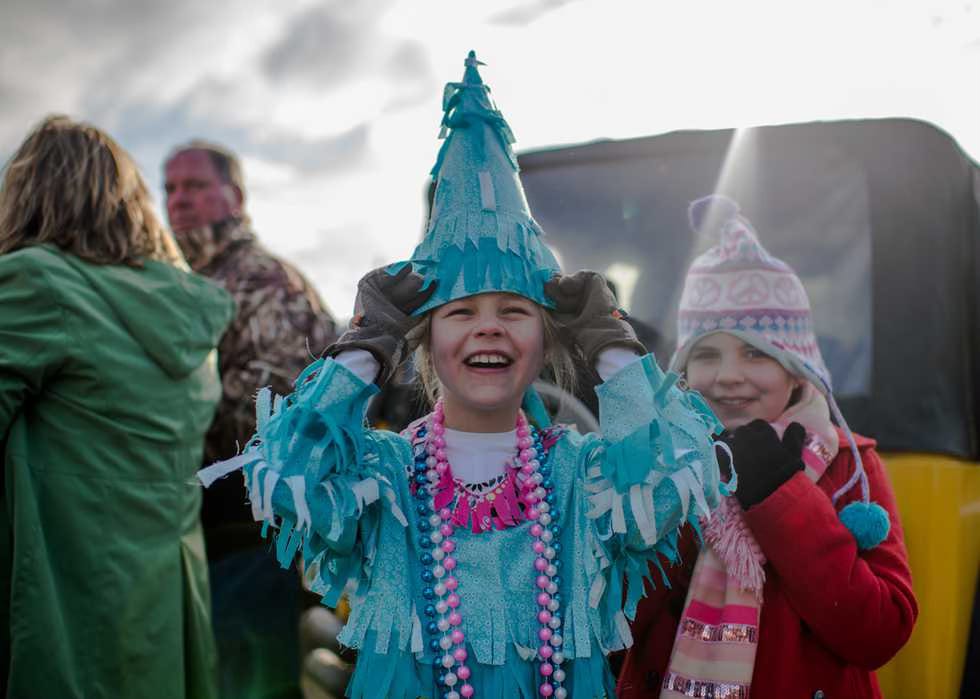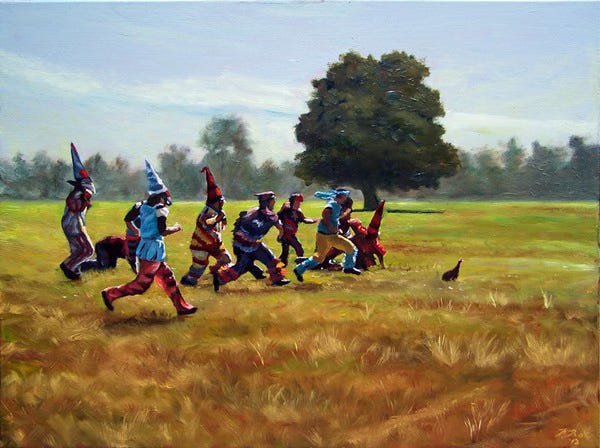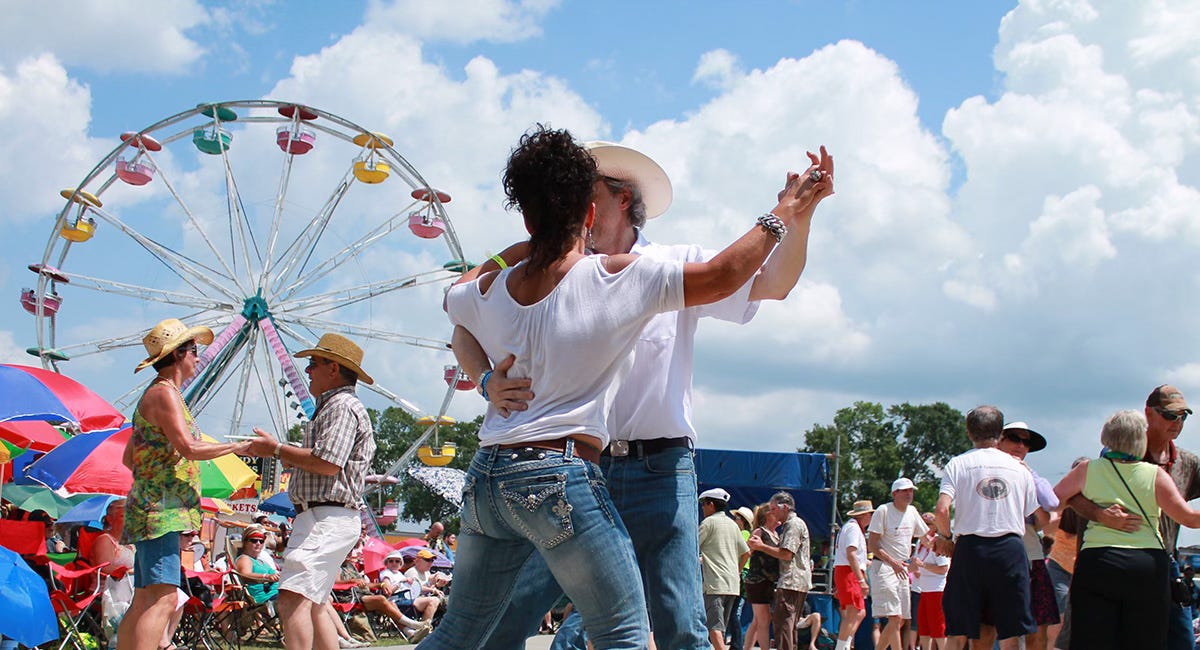Courir de Mardi Gras: The Rural Tradition You Didn’t Learn About in School
By The Bayou Insider Staff
When most people hear “Mardi Gras,” they think of Bourbon Street—glittering floats, feathered costumes, beads raining from balconies, and brass bands leading dance lines through the French Quarter. It’s loud, colorful, and chaotic in all the ways New Orleans knows best. But beyond the parades and party lights, tucked into the prairies and backroads of Cajun country, another Mardi Gras unfolds—one that's older, wilder, and steeped in tradition.
This one doesn’t have tourists or corporate sponsors. Instead, it has mud-stained boots, homemade masks, and masked riders chasing chickens through open fields while accordion music blares in the background. This is Courir de Mardi Gras, and it’s one of the most distinctive cultural celebrations in all of Louisiana—yet you probably never heard about it in school.
🐓 What Is Courir de Mardi Gras?
When most people think of Mardi Gras, they picture the electric energy of New Orleans—gleaming floats rolling through the French Quarter, crowds shouting for beads, and jazz music echoing through the streets. It’s a celebration of excess, color, and community, all wrapped in the glamour of Crescent City tradition.
But just a couple hours west, deep in the heart of Cajun country, a very different Mardi Gras takes place. There are no floats, no celebrity grand marshals, no choreographed throws. Instead, you’ll find muddy backroads, handmade costumes, and a raucous crew of masked riders chasing live chickens across fields, singing old French songs, and begging for ingredients to make a giant community gumbo.
This is Courir de Mardi Gras—a tradition that’s part celebration, part performance, part spiritual ritual, and all heart. It’s Mardi Gras stripped to its roots: raw, raucous, deeply communal, and rooted in centuries of culture and faith.
The courir (which means "run" in French) is a roaming, costume-clad procession where community members travel from house to house—often on horseback or trailers—requesting food items for the evening’s feast. It’s chaotic, joyful, and layered with meaning. There are captains who enforce order with whistles and whips, costumed revelers playing music and dancing in the streets, and children wide-eyed with excitement at the wild spectacle before them.
It’s not something you’ll find in a textbook or a tourism brochure. But for many Cajuns, it’s the most authentic Mardi Gras of all—a tradition passed down through generations, fueled by joy, hospitality, and the enduring spirit of South Louisiana.
🇫🇷 French Roots in the Louisiana Soil
To understand Courir de Mardi Gras, you have to go back—not just decades, but centuries. The roots of this rural Louisiana celebration stretch all the way to medieval France, where communities marked the beginning of Lent with roaming festivals called “fêtes de la quémande” (begging feasts). Dressed in outlandish costumes and masks, peasants would travel door to door, offering music, dance, and slapstick antics in exchange for food and drink before the season of fasting began. These events were lively, satirical, and often involved mocking the wealthy and powerful.
Fast forward to the 18th century, when French Catholic settlers—many of whom were Acadians exiled from Canada—arrived in the swamplands and prairies of what would become south Louisiana. Isolated from major cities and formal infrastructure, they held tightly to their cultural and religious traditions, including this unique form of Mardi Gras.
Over time, what began as a European folk ritual evolved into a distinctly Cajun expression of celebration and survival. In a region where communities were separated by miles of muddy roads and bayous, Courir de Mardi Gras became a way to bring people together before the solemn season of Lent. It was practical, too—gathering ingredients from neighbors helped ensure that everyone could partake in the final feast.
But it wasn’t just about food. It was about preserving identity in a place that often tried to erase it. For generations, Cajun French language and customs were dismissed as backward or un-American. Courir de Mardi Gras persisted anyway, growing stronger in the face of modernity, government suppression of the French language in schools, and cultural assimilation.
Today, that same spirit of resistance and resilience is baked into every gumbo pot stirred on Mardi Gras day. The courir is more than a party—it’s a living connection to the past, a cultural fingerprint that reminds Louisiana’s Cajun communities of where they came from, and why their stories matter.
🥣 How It Works: A Day of Costumes, Chaos, and Community
The day of the Courir de Mardi Gras begins early—sometimes before sunrise. There’s a kind of electric buzz in the air as townsfolk gather in barns, trailers, or backyards to suit up in their homemade costumes. Out come the masks, the tall capuchon hats, and the colorful patchwork clothing designed to disguise identities and add to the sense of playful anonymity.
But this isn’t a parade you watch from the curb—this is a parade you become part of.
Once assembled, the group is led by a capitaine, a highly respected (and slightly feared) figure who wears a distinct outfit, often carries a whip or flag, and keeps order throughout the run. The capitaine’s job is to maintain tradition, ensure safety, and make sure the tone stays festive—not reckless.
As the procession begins, riders—often on horseback or hay-filled trailers—head down country roads, visiting homes and farms throughout the countryside. At each stop, the group dismounts, sings a traditional Cajun French song asking for a donation to the gumbo pot, and performs outrageous dances or skits to entertain the homeowners.
One of the most anticipated parts of each visit is the chicken chase. If the homeowner agrees, they’ll toss a live chickeninto the yard or field—and with wild cheers, the costumed riders sprint after it, trying to catch it by hand. It’s slapstick. It’s muddy. And it’s deeply symbolic: a nod to the tradition’s humble origins, when collecting ingredients was both necessity and community ritual.
But it’s not just about catching chickens. Some homes offer sausage, rice, onions, or other gumbo staples. Others might offer a little something to sip on—often homemade—and encourage the group to keep dancing before moving on to the next stop.
Throughout the day, you’ll hear the sounds of accordion, fiddle, and triangle—the heartbeat of Cajun music—blending with laughter, hoots, and songs sung in old French. The revelry is loud, joyful, and rooted in the sacred idea that everyone contributes, and everyone celebrates together.
After several hours—and many miles—the courir returns to town, where a giant communal gumbo is cooked with all the gathered ingredients. A live band plays, families dance, and stories from the day are passed around like heirlooms. For many small towns, this is the highlight of the year—a time when old traditions breathe, children learn the rhythms of their ancestors, and the bonds of community are renewed.
And by nightfall, as the gumbo is finished and the music winds down, the spirit of the Courir de Mardi Gras lingers—muddy boots, sore legs, and full hearts.
🎭 The Meaning Behind the Mask
The costumes of Courir de Mardi Gras might look like pure chaos—patchwork fabrics, tall pointed hats (capuchons), and wild, mismatched colors—but they’re steeped in symbolism, history, and meaning. In fact, there’s a method to the madness, and the disguise is central to the spirit of the celebration.
The most recognizable piece of the costume is the capuchon, a tall cone-shaped hat that often resembles a court jester’s or dunce’s cap. This headgear isn’t just whimsical—it’s satirical. In medieval France, these pointed hats were used during pre-Lenten festivals to mock the aristocracy and clergy, flipping the social order on its head before Lent reminded everyone of humility. Courir participants today still embrace that spirit, using humor and costume to poke fun at status, power, and pride.
Masks are just as important. Often hand-sewn or crafted from screen material, they obscure the wearer's identity, creating space for people to act freely, without judgment or social inhibition. In a tight-knit town, it’s liberating to dance on someone’s porch or chase a chicken through a field when no one knows it’s you. There’s a joyful anonymity in it all—a chance to play, laugh, and step outside the ordinary.
The costumes also serve a unifying purpose. While every person may dress differently, the shared look—a riot of color, movement, and absurdity—levels the field. It’s a celebration where no one’s too important, too polished, or too proud to participate. Everyone is part of the same ragtag procession. Everyone plays the fool for a day. That’s the point.
In a deeper sense, the act of covering oneself—of putting on a mask and stepping into a new role—mirrors the spiritual act of self-examination. Mardi Gras is, after all, the eve of Lent, a season of reflection, repentance, and renewal. For Cajun Catholics, the courir is both release and preparation: a burst of laughter before the quiet fast.
So while the masks and costumes may look silly or crude to outsiders, they carry the weight of generations of tradition, satire, resistance, and reverence. To put one on is to step into history—and to keep that history alive for another year.
📍 Where It Happens
While New Orleans gets the headlines, the heart of Courir de Mardi Gras beats loudest in the small towns and backroads of Acadiana, where families have kept this rural Mardi Gras tradition alive for generations. Each town brings its own twist—some more rowdy, some more family-friendly—but all stay rooted in the values of community, culture, and Cajun identity.
Mamou – Perhaps the most famous of the courirs, Mamou’s version is rowdy, traditional, and strictly for men. The town takes great pride in preserving the original customs, with songs sung in Cajun French and costumes handmade by locals. The Mamou run is known for its high energy and deep authenticity, drawing crowds from across the state and beyond.
Eunice – Just down the road, Eunice offers a more inclusive and family-oriented experience. The city hosts a multi-day celebration that includes a children’s courir, live music, street dancing, and one of the best cultural showcases in the region. It’s a great place for newcomers to experience the courir in a welcoming and festive environment.
Church Point – One of the oldest and most colorful runs in the region, Church Point’s Courir de Mardi Gras is steeped in community spirit and spectacle. The event includes a vibrant parade and an entire weekend of festivities. Its rich traditions are paired with a party atmosphere that welcomes both locals and visitors alike.
Iota – Known for blending cultural education with celebration, Iota’s courir highlights the history of Cajun Mardi Gras with guided demonstrations, exhibits, and a family-friendly run. It’s an ideal destination for those who want to learn as much as they party—and maybe teach the kids a few French words along the way.
These towns and others across Acadiana may differ in how they run their courirs, but they all share the same heartbeat: a fierce pride in their Cajun roots and a commitment to passing this living tradition on to the next generation.
✝️ Faith, Folklore, and the Feast
At its core, Courir de Mardi Gras is a reflection of the Catholic calendar, rooted in the rhythms of faith and tradition. Mardi Gras—French for “Fat Tuesday”—is the final day of feasting and celebration before Ash Wednesday, which marks the beginning of Lent, a 40-day period of fasting, reflection, and repentance leading up to Easter. Historically, it was a time to use up rich ingredients like meat, butter, and sugar before entering a season of spiritual discipline.
But in Cajun country, this pre-Lenten celebration grew into something uniquely rich: a mix of faith, folklore, and food, wrapped in costumes, laughter, and community.
The religious underpinnings are still strong. Many participants see the courir not simply as a party, but as a form of spiritual preparation—a last wild burst of joy before turning inward. The act of giving and receiving food, especially in such a communal way, echoes biblical themes of hospitality, generosity, and shared table fellowship. And while the satire and revelry may seem irreverent at first glance, it’s all part of a deeper rhythm—a joyful acknowledgment of our shared humanity before stepping into the humility of Lent.
Folklore also plays a central role. Each town has its own stories, songs, and rituals passed down through generations. The chicken chase, for example, may seem like comic relief, but it has symbolic roots in ancient fertility rites and pre-Christian customs, representing the connection between people, land, and the food that sustains them.
And then, of course, there’s the gumbo—the feast at the heart of the courir. It’s more than a meal. It’s a metaphor.
Each home visited contributes something: a vegetable, a sausage link, a live chicken. No single person provides everything, but everyone contributes something. When it all comes together in the giant black pot, it becomes something bigger than the sum of its parts—a warm, spicy, communal expression of Cajun culture and survival.
Music, too, is essential to the celebration. Live Cajun and Zydeco bands provide the soundtrack of the day, blending African, French, and Caribbean influences into something distinctly Louisianan. Dancers of all ages fill the streets and halls, spinning, laughing, and stomping out a rhythm that’s been handed down through generations.
In the end, Courir de Mardi Gras isn’t just a cultural tradition or a quirky celebration—it’s a living tapestry of faith, heritage, and joy, where people come together to eat, laugh, remember, and prepare their hearts for what comes next.
📈 The Modern Revival
By the mid-20th century, Courir de Mardi Gras was on the brink of fading into memory. With the rise of modern entertainment, urbanization, and pressure to assimilate into mainstream American culture, many of Louisiana’s small-town traditions—especially those conducted in Cajun French—began to disappear. The courir, once a staple of Mardi Gras in rural parishes, was often dismissed as outdated, strange, or even embarrassing by younger generations seeking a different kind of life.
But starting in the 1960s and 1970s, a cultural renaissance began to stir. Scholars, folklorists, and proud locals—some of whom had participated in the courir as children—began working to preserve Cajun traditions, language, music, and festivals. Organizations like CODOFIL (Council for the Development of French in Louisiana) promoted the revival of Cajun French and celebrated its rich cultural contributions.
The Courir de Mardi Gras was reborn—not as a tourist attraction, but as a cherished symbol of cultural survival and identity. Towns like Mamou, Eunice, and Church Point began hosting public courirs again, with local leadership ensuring the rituals remained intact and respected.
Today, the courir is thriving. What was once an obscure folk ritual is now drawing national and even international attention, with journalists, photographers, and visitors seeking a more “authentic” Louisiana Mardi Gras experience. Documentaries, podcasts, and cultural tourism have all helped shine a light on the courir’s history and significance.
But with that attention comes a challenge.
Many towns now carefully balance the growing crowds and media attention with a desire to protect the soul of the tradition. Some courirs remain closed to the public or require participants to be locals or fluent in Cajun French. Others welcome guests, but with strict rules around costumes, behavior, and respect for the spiritual and historical elements of the event.
What’s clear is that this isn’t just a quirky celebration for social media photos—Courir de Mardi Gras is a living, breathing expression of Cajun identity. It’s survived exile, erasure, ridicule, and commercialization. And through grit, faith, and a lot of gumbo, it’s flourishing again.
💬 Why It Matters
In a world moving faster than ever—where traditions are often traded for trends and roots are easily forgotten—Courir de Mardi Gras stands as a powerful reminder of what matters most: community, culture, and connection.
This isn’t just a quirky event tucked away in the backroads of Louisiana. It’s a living expression of resilience, a celebration that has outlasted exile, assimilation, and the pressure to conform. Every costume sewn by hand, every song sung in Cajun French, every bowl of shared gumbo tells a story of people who refused to let their heritage die.
It matters because it’s more than spectacle—it’s a way of life handed down across generations. In the courir, children ride beside grandparents. Neighbors share food, laughter, and faith. Towns come together not in isolation, but in solidarity—each person playing a role, each voice adding to the music of the moment.
And it’s precisely because it hasn’t been polished or packaged for mass consumption that it feels so rare, so real. Courir de Mardi Gras matters because it shows us that traditions don’t have to be grand to be meaningful—they just have to be kept alive.
So whether you were raised in the bayous or just learned about this for the first time, consider this an invitation: to celebrate not only the color and chaos of the courir, but the deep cultural heartbeat behind it. To see it not just as a party before Lent, but as a mirror of the values Louisiana holds dear—faith, family, food, and fierce love for where you come from.
🔎 Want to Experience It?
If reading about Courir de Mardi Gras has sparked your curiosity—or tugged at something deeper—you’re not alone. Every year, more people from across Louisiana and beyond travel to Cajun country to witness this one-of-a-kind celebration. And while it’s not your typical Mardi Gras experience, that’s exactly the point.
To experience a courir is to step into a living tradition—one where you’re not just a spectator but a welcome guest in a centuries-old story. But before you pack your boots and hop in the car, it’s important to know that this celebration isn’t a tourist trap. It’s a sacred cultural ritual that demands respect, openness, and a willingness to engage on local terms.
Here’s how to do it right:
Choose the right town: Start with places like Eunice or Iota for a more family-friendly, inclusive experience. These towns often host events that are open to the public and include educational components, music festivals, and traditional cooking demonstrations. For a more traditional (and rowdier) experience, Mamou or Church Point may be the ticket—but some events there may be closed to outsiders or limited to locals only.
Do your homework: Check festival schedules, contact tourism offices, or visit official event websites in advance. Some towns require participants or observers to register or adhere to dress codes, especially if you’re planning to ride or follow the courir.
Dress appropriately: While you don’t have to wear a full courir costume (unless invited), this isn’t the place for flashy Mardi Gras beads or party hats. Comfortable clothes, mud-friendly boots, and layers for unpredictable weather are key.
Be respectful: Ask before taking photos, especially of individuals in costume. Participate when welcomed, observe when appropriate, and remember that this is someone else’s tradition—not just entertainment.
Support local: Eat at local diners, shop at nearby stores, and tip the musicians playing at the street dances. Your presence should be a blessing to the town, not a burden.
And finally—immerse yourself. Listen to the music. Ask questions. Eat the gumbo. Learn a few words of Cajun French. The beauty of the courir isn’t just in what you see—it’s in what you feel: the connection to land, language, and legacy.




